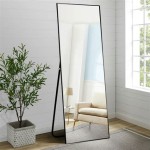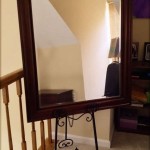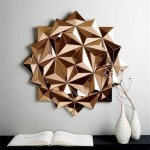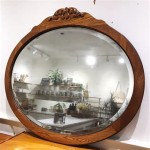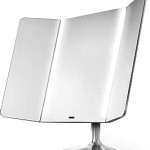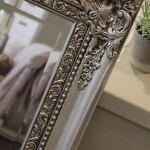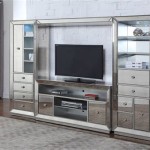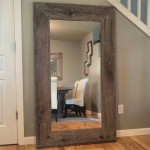How To Tell If A Mirror Is Double Sided
Determining whether a mirror is single or double-sided involves observing its reflective properties and construction. Several methods can be employed to distinguish between these two types of mirrors, ranging from simple visual inspections to more involved techniques.
The Fingernail Test: One of the most common methods for checking if a mirror is two-way is the fingernail test. Place a fingernail against the reflective surface. If there is a gap between your fingernail and its reflection, it's likely a standard, single-sided mirror. This gap occurs because the reflective layer is on the back surface of the glass. If the reflection appears to touch the fingernail, with little to no gap, the mirror could be two-way. This is because the reflective surface is on the front, eliminating the layer of glass that creates the gap in a standard mirror.
Light Transmission Test: The light transmission test relies on the principle that two-way mirrors allow some light to pass through. In a darkened room, shine a bright flashlight against the mirror's surface. If some light penetrates through, illuminating the area behind the mirror, it suggests a two-way mirror. A standard mirror will reflect almost all the light, preventing significant illumination from passing through.
Observe Surroundings for Discrepancies: This method involves analyzing the environment surrounding the suspected two-way mirror. Look for indications of observation, such as hidden cameras, microphones, or unusual lighting arrangements. Two-way mirrors are often used in observation rooms, so any signs of surveillance equipment should raise suspicion.
Sound Test: While not foolproof, the sound test can provide further clues. Tap on the mirror's surface and listen to the sound produced. A two-way mirror, due to its thinner construction, might produce a slightly hollower, brighter sound compared to a standard mirror, which usually has a more muted, solid sound due to the thicker backing.
Observe the Mirror's Mounting: Examine how the mirror is mounted. Two-way mirrors are typically installed within a wall or frame to conceal the observation area behind them. If the mirror seems unusually thick or is set into the wall in a way that suggests a concealed space behind it, it warrants further investigation using other methods.
Consider the Context: The location and context of the mirror are crucial factors. Two-way mirrors are more likely to be found in locations where observation is common, such as police interrogation rooms, security checkpoints, or certain retail settings. Finding a mirror in a private residence or a less conventional setting reduces the likelihood of it being a two-way mirror.
Professional Inspection: If doubts persist after applying these methods, consulting a glass professional or security expert is recommended. They possess the knowledge and tools to definitively determine the mirror's type. They can use specialized equipment to measure the light transmission and reflective properties with greater accuracy.
Limitations of the Fingernail Test: While readily available and widely known, the fingernail test has limitations. Some modern manufacturing techniques can create standard mirrors with minimal gaps, making the test less reliable. Furthermore, the test's accuracy depends on the observer's perception and the specific characteristics of the mirror.
Understanding Two-Way Mirror Construction: Two-way mirrors, also known as one-way mirrors, are made by applying a thin metallic coating to a glass surface. This coating reflects some light while allowing a portion to pass through. The effect of the mirror being "two-way" depends on the lighting conditions on either side. The brighter side appears reflective, while the dimmer side allows observation.
Importance of Multiple Methods: Relying on a single method may not provide conclusive results. Employing multiple techniques in conjunction, such as the fingernail test, light transmission test, and observation of surroundings, provides a more comprehensive assessment and strengthens the confidence in the determination.
Safety and Privacy Considerations: If a two-way mirror is suspected in a private or sensitive setting, it is crucial to take appropriate safety and privacy precautions. This may include contacting law enforcement, security professionals, or taking measures to block observation.
Reflective Films: It's important to note that not all reflective surfaces are traditional glass mirrors. Reflective films, which can be applied to various materials, can also create a two-way effect under certain lighting conditions. Therefore, considering the material and how it's applied is essential.
Angle of Incidence: The angle at which light strikes the mirror also plays a role in its reflective properties. While not a definitive test for a two-way mirror, observing how the reflection changes at different angles can offer additional clues about its construction and reflective characteristics.
How You Do A Quick Check For Cams Or Two Way Mirrors In Trial Rooms Quora

How To Tell If A Mirror Is Two Way Or Not 8 Steps With Pictures S Hotel Mirrors

How To Tell If A Mirror Is Two Way Or Not 8 Steps With Pictures

How To Tell If A Mirror Is Two Way Or Not 8 Steps With Pictures

What Is A Two Way Mirror Quora

Forwarded Messages A Mirror Or 2 Way Glass Two Helpful Hints

Fingernail Test Comparison Between Standard Mirror And Acrylic Two Way Mirrors

How To Tell If A Mirror Is Two Way Or Not 8 Steps With Pictures

How To Tell If A Mirror Is Two Way Or Not 8 Steps With Pictures

How To Tell If A Mirror Is Two Way Or Not 8 Steps With Pictures

